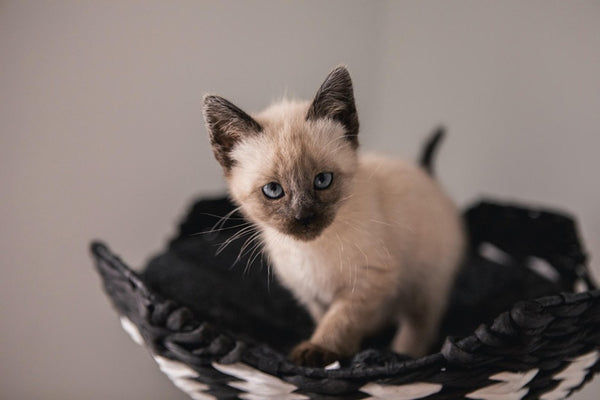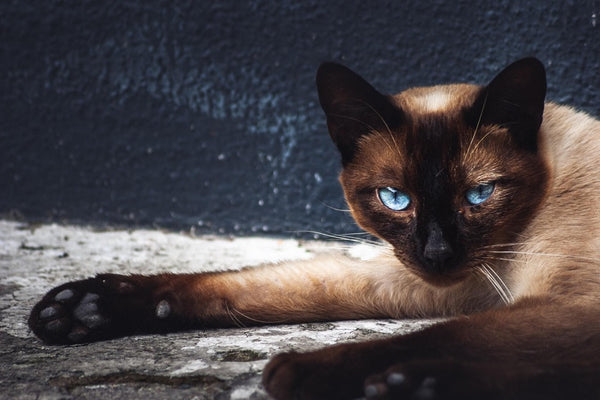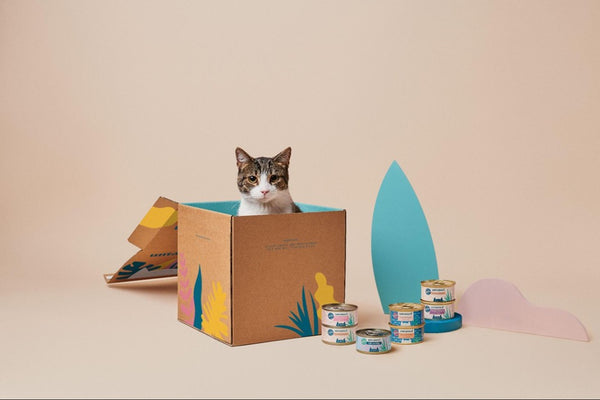20.06.2022
How to determine whether your feline is a half-Siamese cat
Many cat parents pay no attention to the breed of their feline companions. While it shouldn't be important when adopting a cat, it can be useful to learn about your feline’s heritage to know what kind of personality to expect, what type of care they need, and what health issues they could be susceptible to.
Do you suspect your feline is a half-Siamese cat and would like to confirm to apply the proper care regimen? This article will tell you all about the physical and psychological characteristics of Siamese cats so you can compare them to your feline.
How to tell if your cat is part Siamese
When determining whether your cat shares genes with the Thai feline royalty, you should consider their:
- Physical traits
- Temperament
Physical traits of Siamese cats
When comparing your cat with a purebred Siamese, you should pay attention to:
- Fur colour
- Eye colour and shape
- Face shape
- Body shape
Siamese cat fur colour
Siamese cats’ fur has distinctive patterns. Their body is typically cream or a pale fawn, while ears, paws, and tail have a darker colour. The darker areas are called points, and they are the most obvious characteristic of Siamese cats. There are many shade variations of the points, but the most common ones are:
- Chocolate
- Blue
- Lilac
- Red
- Cinnamon

Siamese cats are born white and get darker points at six months.
Source: Kristin Brown
Siamese kittens are born completely white. They get their final colours after 12 months, while the first signs of darker shades start appearing around the sixth month. If you have a kitten, you will have to wait until they grow a bit to confirm they have Siamese genes.
Siamese cat eye colour and shape
Besides the point pattern, the most identifiable trait of the Siamese breed is their almond-shaped, blue eyes. The shade can range from light to darker ocean blue. This trait is present in Siamese kittens from birth—they are all born with deep blue eyes.
If your feline has blue eyes, they are most likely of Siamese descent.

All Siamese cats are born with blue eyes.
Source: Marek Piwnicki
Siamese cat face shape
Over the decades, breeders have created different types of Siamese cats, and you can usually tell them apart by analysing their face shape. For example, the traditional Applehead Siamese cat has a round face resembling an apple and smaller ears, as opposed to an Old-Style Siamese who has an elongated face and large ears that are wide at the base and rounded at the top. The Modern Siamese has an angular face and big pointy ears set lower on the sides of their head, while the head shape of the Classic Siamese is somewhere between rounded and pointed, and they have relatively large ears.
If your cat has an angular face, it’s probably a Siamese mix (unless they were mixed with an Applehead).
Siamese cat body shape
Different types of Siamese cats have specific body shapes. Refer to the table below to check out the differences and compare them to your cat:
|
Traditional Siamese cat (Applehead) |
Modern Siamese cat |
Classic Siamese cat |
Old-Style Siamese cat |
|
|
|
|
Siamese cat temperament
Siamese cats have distinctive personalities. Your kitty might be part Siamese if you recognise these qualities in their character:
- Outgoing personality
- Intelligence
- Chattiness
- Mood swings
Siamese cats are sociable
Siamese cats are wonderful pets. They are playful, kid-friendly, and love the company of people and other animals. Since many other cat breeds—such as Ragdolls, Maine Coons, and Bengals—are equally friendly and sociable, determining whether your cat is half-Siamese by focusing on this trait can be challenging.
Few breeds can match the Siamese cat’s intelligence
Curiosity is a sign of intelligence, and Siamese cats are highly inquisitive. They love to explore and thrive in stimulating environments but get bored easily, which means you need to provide plenty of toys, preferably interactive ones, and food puzzles.
Due to their intelligence, Siamese cats are easily trainable, and the reward-based approach is the most effective way to teach them various tricks or promote specific behaviour.
Siamese cats are vocal
If you ask a purebred Siamese cat parent to describe their feline companion, they will not fail to mention their chattiness. These cats are probably the loudest breed. They will meow to tell you they love or miss you, scold you, or demand your attention.
They can get moody
Siamese cats are attention seekers. They need your love, affection, and undivided attention all the time. We can go out on a limb and say they can be pretty high-maintenance. If they lack cognitive stimulation, you don't pay enough attention to them, or they don’t have enough space and opportunities to exercise, they can become depressed and anxious and develop unwanted behaviour, such as biting and other forms of aggression.

How dare you not pay attention to me?
Source: Alexandr Popadin
All pets require love and time, but some do so more conspicuously. Siamese cat mixes will likely be more demanding.
What if you still can't tell whether your cat is part Siamese?
The only surefire, albeit costly, way to find out the genetic background of your cat is to perform DNA analysis. You can send your cat’s hair follicle to an agency that performs DNA testing, and they will send you a complete analysis of your cat's breed. You will know the exact cat breeds involved in the making of your kitty, which will help you establish an adequate care regimen and ensure your kitty is healthy and happy.
Another benefit of DNA analysis is that it can help you determine whether your cat has any genetic disorders. While you won't be able to do much to prevent them, you could be able to manage the condition with proper care and diet.
Health issues to watch out for if your cat is part Siamese
Mixed breeds are typically more resilient and healthier than purebreds, but they can still inherit certain health issues. Half-Siamese cats can be prone to:
- Respiratory infections—Respiratory infections are usually caused by two common pathogens
- Feline rhinotracheitis virus—You will notice your cat drooling and sneezing excessively
- Feline calicivirus—Affected felines often have ulcers around their nose and mouth, nasal and eye discharge, feel general discomfort and pain
- Asthma—Asthma is a common chronic respiratory disease in cats. It is progressive and incurable. The symptoms include coughing, wheezing, and distressed breathing
- Vestibular disease—The vestibular apparatus is located in the felines’ ears and is responsible for maintaining balance, sense of orientation, and direction. When there is a problem with it, your cat suddenly loses coordination, starts circling, and falling, and feels dizzy and disoriented
- Agenesis of the upper eyelid—This condition keeps the upper eyelid underdeveloped. There are several treatment options, such as antibiotics and artificial tears for milder cases or a surgical procedure and eye removal for severe cases
- Progressive retinal atrophy (PRA)—If your cat was born with a degenerative gene that causes progressive damage to cells responsible for light reception at the back of the eye, they will gradually lose their eyesight until they go completely blind, which usually happens within four years after the first symptoms appear
Half-Siamese cats are also prone to certain acquired illnesses, such as:
- Obesity
- Diabetes
- Kidney disease
- Urinary tract infections
- Bladder stones
- Cystitis
You can prevent or keep these issues under control with a healthy diet.
The best feline diet—half-Siamese or not
Nutrition is an essential part of caring for your cat, so you must learn what their diet should consist of and what ingredients to avoid. Feeding your half-Siamese cat well-balanced and adequately portioned meals can help keep them healthy.

I like the box, and I love the food.
Image (c) Untamed
The meals you offer should contain the right balance of:
- Animal protein—Protein content in cat food should be at least 50%, and you should opt for cat food made with high-quality whole meat and fish, such as chicken breast, turkey, liver, mackerel, tuna, and shrimp. Meat is the only source of essential amino acids, such as taurine and arginine, that cats need for normal organ function, muscle growth, and healthy coat and skin
- Animal fat—This nutrient is crucial because it gives food an irresistible flavour and ensures your cat's immune response is strong, which can prevent many respiratory diseases that your half-Siamese can experience. The animal fat content in cat food should be under 20% to avoid weight gain
Ingredients to avoid
Many commercial cat foods contain ingredients that have little to no nutritional value for felines. Ingredients you should steer clear of include:
- Additives, including taste enhancers, preservatives, artificial colouring, sodium, and sugar
- Grains, such as wheat, rice, corn, sweetcorn, soya
- Vegetables and legumes (e.g. peas, potatoes, sweet potatoes, beans, carrots, broccoli, pumpkin, mushrooms)
- Dairy products, including milk and cheese
Besides being completely useless to felines, these ingredients can also cause various health issues, such as:
Should you go for wet or dry food?
Cat parents often have difficulty deciding what type of cat food to choose—wet, dry, semi-moist, raw, B.A.R.F., or homemade. While some cat parents opt for dry food because it is more convenient and affordable, most vets recommend basing your feline's nutrition predominantly on wet food.
Kibble often contains filler ingredients such as grains, sugar, and additives. It also has a low moisture content (only around 10%), which can be harmful to felines as they have a low thirst drive and are used to getting hydration through food.
Wet cat food, besides typically being free of filler ingredients, contains much more moisture (around 70%), and cats have no trouble digesting high-quality canned products. The increased moisture helps prevent dehydration and health issues such as kidney diseases and urinary infections.
See how Untamed can help you keep your Siamese mix healthy
We know that the best diet for your feline resembles their natural eating habits (in nature, cats eat slugs, birds, mice, and other small animals, but we mimic it with human-grade meat and fish). That’s why we strive to ensure all kitties get the perfect protein-to-fat ratio in each meal.
Every Untamed tin is:
- High in protein—Our food contains twice as much protein as most other commercial products. Our recipes contain around 60% of whole meat!
- Sugar-free—Cats can’t taste sweet, and sugar can be harmful to their overall health. Many manufacturers use this ingredient to make their cat food more appealing to buyers, but ingesting too much sugar can cause cramps, flatulence, nausea, vomiting, and high blood pressure. We steer clear of anything that can cause your kitty discomfort and health issues
- Grain-free—Grains are an unnecessary ingredient in cat food, and many felines are sensitive to it. This ingredient can cause skin irritation, weight gain, diarrhoea, and vomiting. Untamed meals contain no filler ingredients, and we avoid all known allergens!
- Low in carbs—Cats don’t need carbs as they should get energy from animal protein only. Too many carbohydrates can lead to unhealthy weight gain

Untamed helps you keep your half Siamese cat healthy and happy.
Image (c) Untamed
Find out why Siamese cat parents love Untamed!
Our jelly and gravy recipes were created under the supervision of vets to ensure your cat's nutritional needs are met regardless of their breed, sterilisation status, or life stage. Untamed meals are suitable for:
- Weaned kittens who need quality food to grow and develop properly
- Adult cats who need to maintain healthy energy levels
- Pregnant queens who need vast amounts of energy to maintain a healthy pregnancy
- Neutered males with weight issues
- Senior cats who lack a few teeth, suffer from gum problems, or have started losing muscle tone
- Fussy cats who haven't been fans of wet food
Create a tailor-made meal plan for your feline by taking our online quiz! Once you switch to Untamed, you will see the benefits in no time.
Check out what cat parents who have tried Untamed say you can expect to see:
|
Timeline |
What Untamed can do |
|
First week |
|
|
After two months |
|
|
After four months |
|
|
Where do I sign up?
Getting healthy and well-balanced meals for your feline friend is as simple as it gets. All you need to do is follow these three steps:
- Complete the Try Now quiz
- Provide some information about your cat
- Choose the best products for your half-Siamese
The trial pack will come in a day, and if your kitty likes the dishes, you can get regular monthly supplies of Untamed meals. An added benefit is that you can postpone, cancel, or modify your order anytime!

![Associated image for What human food can Sphynx cats eat? [Comprehensive list]](http://untamed.com/cdn/shop/articles/what_human_food_can_sphynx_cats_eat_Featured_400x300_crop_center.jpg?v=1648705074)










